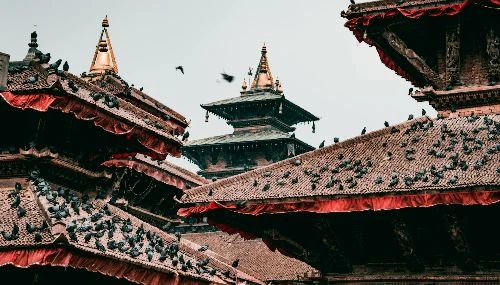Introduction
White Gumba, also known as Seto Gumba, is a Tibetan Buddhist monastery located in Kathmandu, Nepal. It has a white facade and a golden spire, and it is located on a hilltop in the city's northwest. The monastery was established in the 1960s by Lama Geshe Wangyal and has since grown to be a glorious destination for both locals and visitors looking for spiritual advice and peace.
For many reasons, the white gumba is a significant spiritual and cultural icon in Nepal. First of all, it is a center for religious practice and one of the most important Tibetan Buddhist monasteries in the nation. It is often seen as a focal point for maintaining and advancing Tibetan culture and customs.
Second, many adore White Gumba for its quiet ambiance, which offers a welcome respite from Kathmandu's bustling daily life. The monastery attracts a lot of tourists who come to think, meditate, and find inner peace.
Finally, the monastery is a must-visit location for everyone traveling to Nepal due to its spectacular architecture and picturesque surroundings. The monastery's striking white facade and golden tower are emblems of Kathmandu's rich cultural legacy and serve as a reminder of the nation's profoundly spiritual foundations.
What is White Gumba?
White Gumba's physical attributes include a sizable stupa, prayer wheels, and a number of buildings that serve as residences for monks and tourists. The stupa, which is the centerpiece of the monastery, is decorated with vibrant prayer flags and elaborate carvings. The stupa's outside circle is surrounded by prayer wheels that can be spun to send blessings out into the surrounding area.
Just outside of Kathmandu, Nepal, on the Nagarjun Hill is where White Gumba rests in all its splendor. Visitors can take a taxi or bus from Kathmandu to the base of the hill and then climb up to the monastery to reach White Gumba. The hike lasts between 45 and an hour, and the track is signposted and simple to navigate. Visitors can also make arrangements for a private vehicle or tour guide to drive them to the monastery.
It is crucial to respect the monks and the site's sacredness when visiting White Gumba. Visitors are advised to wear modest clothing, take off their shoes before entering any structures, and avoid recording or photographing religious activities. Shows of affection publicly is unwelcome at the Gumba.
At White Gumba, tourists can do a variety of other things in addition to touring the monastery and taking part in religious rituals. They include going on hikes and exploring the nearby hills, taking in panoramic views from hilltops, and learning about Tibetan Buddhism's history and culture.
However, there are a few things that visitors to White Gumba should avoid doing. Loud talking, littering, unauthorized contact with holy things, and acting disrespectfully are a few examples. Visitors can make sure they have a meaningful and delightful experience at White Gumba by being courteous and conscious of the spiritual character of the location.
History of White Gumba
In the 1960s, Lama Geshe Wangyal, a Tibetan Buddhist monk who had fled Tibet after the Chinese invasion in 1959, founded White Gumba, also known as Seto Gumba, in Nepal. After settling in Nepal, Lama Geshe Wangyal started instructing Western and Nepali pupils in Tibetan Buddhism. To create a place where Tibetan Buddhism might be studied and practiced, he established White Gumba.
The founding of White Gumba was crucial to the development of Tibetan Buddhism in Nepal. Before its founding, Nepal had just a small number of Tibetan Buddhist monasteries, and the faith was not particularly popular there. Yet, many Nepalis started to get interested in Tibetan Buddhism and its teachings with the founding of White Gumba.
White Gumba has developed into a center for Tibetan Buddhist study and practice in Nepal throughout time, drawing both national and foreign students. The monastery offers instruction and instruction in a variety of Tibetan Buddhist activities, including ritual, meditation, and philosophy.
Lama Geshe Wangyal, who established the monastery and was instrumental in bringing Tibetan Buddhism to Nepal, is one of the most significant individuals in the history of White Gumba. He was a beloved teacher to many of his students and was well-respected for his intelligence and experience.
Khen Rinpoche Geshe Lobsang Tharchin, who succeeded Lama Geshe Wangyal as the abbot of the monastery in 1983, is another important character in the history of White Gumba. In addition to being a highly esteemed teacher and scholar, Khen Rinpoche Geshe Lobsang Tharchin carried on Lama Geshe Wangyal's efforts to advance Tibetan Buddhism in Nepal.
The 2015 Nepal earthquake caused significant damage to White Gumba. The monastery was later reconstructed, though, and it now plays a crucial part in advancing Tibetan Buddhism and safeguarding Nepal's cultural legacy.
Religious Significance of White Gumba
Tibetan Buddhists in Nepal and around the world consider White Gumba to be a major spiritual and religious location. The Gelugpa school of Tibetan Buddhism, which is well-known for emphasizing learning and meditation, is affiliated with the monastery.
White Gumba is a site of retreat and spiritual pilgrimage for Tibetan Buddhists. Many people go to the monastery to participate in rituals including offering, prayer, and meditation. Many Tibetans consider the monastery to be a site of spiritual blessings and strength, and they think that walking around the stupa and chanting mantras might have a positive spiritual impact.
White Gumba is also connected to a variety of Tibetan Buddhism-specific rites and customs. They include tsok, which entails participants exchanging food and beverages, and puja, which refers to ritual offerings. The monastery also holds many celebrations and ceremonies throughout the year, including the Butter Lamp Festival and Losar (the Tibetan New Year).
White Gumba has contributed significantly to the growth of Buddhism in Nepal in addition to its spiritual value. Many Nepalis have been introduced to Tibetan Buddhism through White Gumba, which has functioned as a center for its study and practice.
Cultural Significance of White Gumba
Due to its connection to Tibetan Buddhism and its function in advancing the religion in the nation, White Gumba has come to represent an essential aspect of Nepalese culture. The monastery has been an important site for the study of Tibetan language and culture and has contributed significantly to Nepal's preservation of Tibetan heritage and culture.
The White Gumba celebrations and activities play a significant role in Nepali and Tibetan culture. Losar, the Tibetan New Year, is among the most important occasions. People congregate to celebrate Losar with music, dance, and eating, and the monastery is decked out with vibrant prayer flags and butter lights. Saga Dawa, a festival that honors the life of the Buddha, is another significant celebration. During Saga Dawa, people congregate to give prayers and sacrifices, and many walk around the stupa at White Gumba.
White Gumba also regularly provides teachings and retreats throughout the year in addition to these festivals. People from all over the world participate in these events, which are crucial for fostering cross-cultural understanding between Tibetans, Nepalis, and other people.
Conclusion
White Gumba is an auspicious place for domestic and international tourists alike. Its wonderful scholarship, the beautiful views of the mountains that surround it, and its development whilst spreading the messages of love and peace throughout the world acting as a symbol of Tibetan Buddhism makes it an unmissable place.


.webp)

